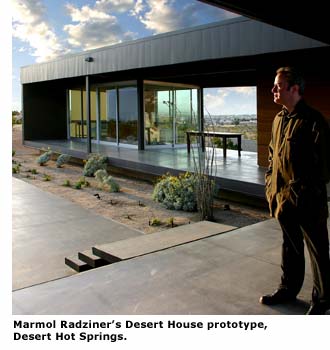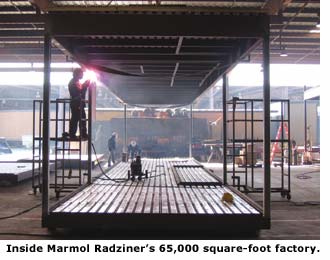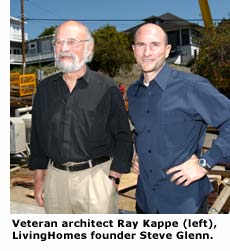Prefabulous or Fad?
 Is America heading for a prefab future?
Is America heading for a prefab future?
Instead of hammering homes together stick by stick, will builders assemble them in climate-controlled factories and then truck them to the site readymade? Will we replace archaic techniques of homebuilding that haven't changed much since the 19th century with methods that are more efficient and environmentally friendly?
And will all of this lead to a resurgence of well-designed modern homes?
If buzz were buildings, the answers would be yes. Young architects across the country are churning out sleek, hip, and ultra-modern 'weeHouses,' 'MetroSheds,' and 'Dockable Dwellings' that are as creatively named as they are designed. The plans are varied, ranging from steel frame to wood frame, from metal siding or plywood to composite panels. They are found all over the Internet and in the popular architectural press and are discussed at packed conferences. Some have even been built.
One of the few architects who has actually seen a goodly number of her designs built is Michelle Kaufmann, whose 22-person Bay Area firm has completed 12 prefabricated homes, has another five underway, and another 50 going through pre-construction paperwork. Also in the works—a Benedictine monastery in the hills of Big Sur.

All are 'modular,' which means they are constructed in a factory as large room-sized, or multi-room 'modules,' complete with walls, floors, ceiling, plumbing, and fixtures, then delivered on site where they are married to their fellow modules and attached to foundation and utilities. Kaufmann's firm will build nothing but modular, she says. "People ask, 'Is prefab just another fad?'" Kaufmann says. "I truly believe it's not a fad but it's a shift in the way we think."
"We think, long term, prefab will be the choice of home building," says Michael Friedman, whose firm Maxx Livingston Modern Homes is developing modular prototypes of designs by Los Angeles architect William Krisel, the primary designer of the Alexander modern tract homes in Palm Springs from the 1950s and '60s. "Having the ability to control quality and pricing, and also have a lower impact on the environment just makes long-term sense. Residential home construction is one of the last mass industries that has truly not taken advantage of line production."
Marmol Radziner Prefab, an offshoot of the Los Angeles-based architectural firm Marmol Radziner + Associates, whose prototype modular home in Desert Hot Springs has attracted much attention, even runs its own 65,000-square-foot factory to produce steel-framed modules fully outfitted with plumbing, drywall, lighting, and tile work. What's most exciting about prefabrication, partner Ron Radziner says, is, "You can bring modern design to more people."

Another proponent of modular homebuilding is Ray Kappe, whose recent modular house for the firm LivingHomes in Santa Monica has been called the best of the new prefabs—by several of Kappe's competitors, no less.
That shouldn't be surprising. Kappe is a pioneer Southern California modernist who has designed hundreds of wood-and-glass houses since the mid-'50s, many of them floating over steep slopes thanks to his signature concrete towers. Everything he designed from the '50s on, Kappe says, anticipated prefabrication. (In the 1950s, working under contract with NASA, he developed modular housing units with portable power units that could break apart and be used as personal transportation!)
"It's kind of great," Kappe said in a recent interview, "to finally do a modular home at a point where you're ready to retire, and now you have an opportunity to do what you've always wanted to do."
Still, not everyone is convinced that prefabs have finally come into their own. Krisel, working with Maxx Livingstone, has a stake in their success and hopes for the best. But he says, "I've been an architect so long, I've seen so much talk about prefab, I'm not sure it will work now. Every time I've been involved with anybody wanting to prefabricate one of my designs—and over the years that's been at least ten times—we've always found that that you could build it with stick for less."
Prefabricated houses were a hot concept in the '50s, and had been since the 1920s, when Le Corbusier in France produced a 'mass-produced house,' followed shortly by Walter Gropius in Germany. In the United States, throughout the Depression, World War II, and the suburban boom that followed, progressive architects dreamed about producing affordable, modern prefab homes for farm workers, war workers, and returning GIs and their young families.




